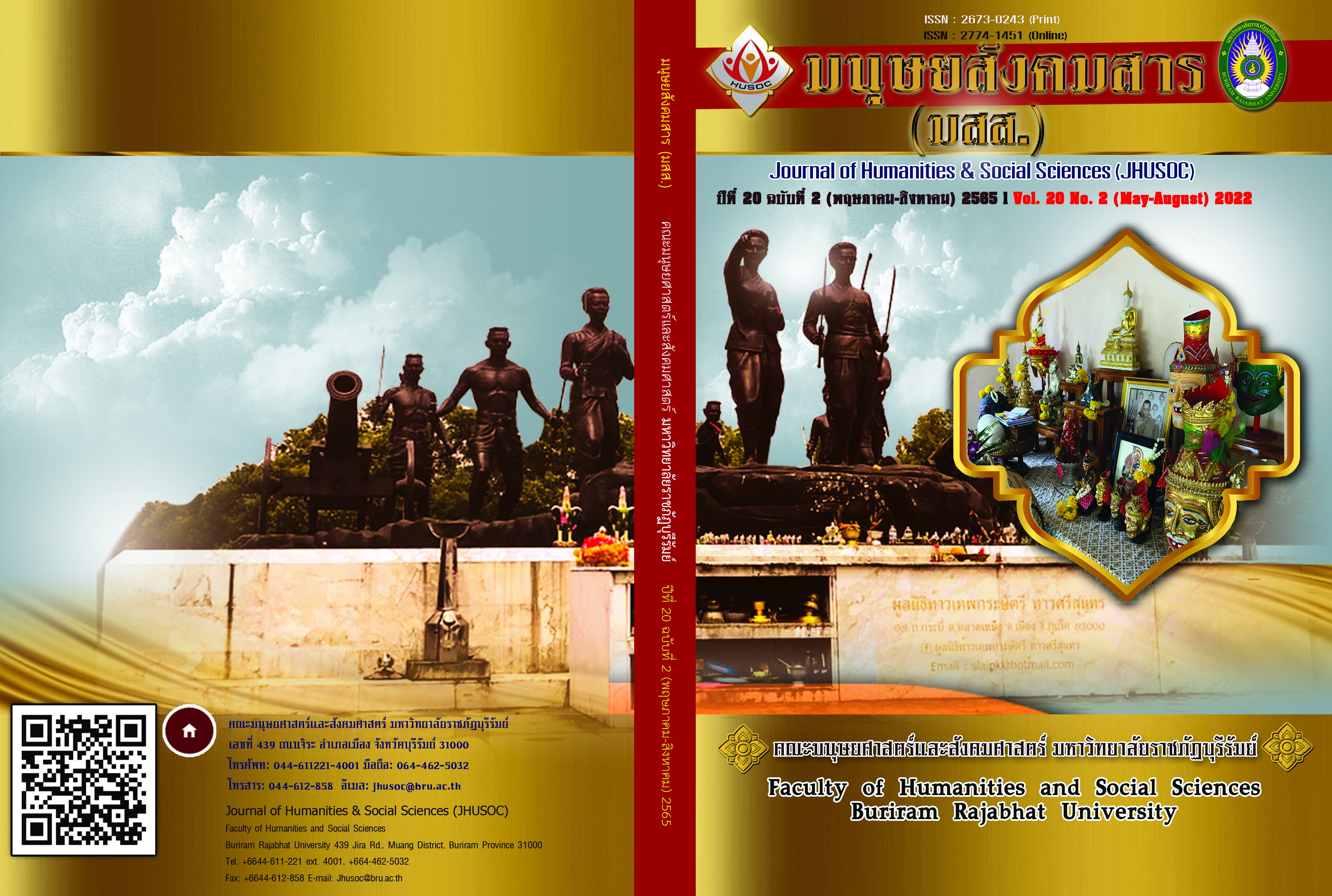ภาพสะท้อนทางวัฒนธรรมจากคำเรียกขานภาษาจีน
Main Article Content
บทคัดย่อ
งานวิจัยนี้มีวัตถุประสงค์เพื่อศึกษารูปภาษาและภาพสะท้อนวัฒนธรรมจากคำเรียกขานภาษาจีนตามมุมมองภาษากับวัฒนธรรม โดยใช้กรอบแนวคิดรูปภาษาคำเรียกขานภาษาจีนของ Ding (2005) และ Sodsongkrit (2010) และกรอบแนวคิด ภาษาสะท้อนวัฒนธรรมของ Su (2006) โดยผู้วิจัยรวบรวมคำเรียกขานภาษาจีนจากละครโทรทัศน์จีน 18 เรื่องผ่านแอปพลิเคชัน WeTV ปีพ.ศ. 2561 - พ.ศ. 2564 จัดหมวดหมู่รูปภาษาของคำเรียกขานและวิเคราะห์ความสัมพันธ์ระหว่างคำเรียกขานภาษาจีนกับภาพสะท้อนทางวัฒนธรรมจีน สถิติที่ใช้ในการวิเคราะห์ข้อมูลคือค่าความถี่และร้อยละ ผลการวิจัยพบว่า 1) รูปภาษาของคำเรียกขานภาษาจีนปรากฏ 5 ประเภท 83 รูป 2) คำเรียกขานภาษาจีนสะท้อนภาพทางวัฒนธรรมจีน 3 ด้าน คือ (1) วัฒนธรรมทางวัตถุ (2) วัฒนธรรมทางจารีตหรือขนบธรรมเนียม ได้แก่ ความสำคัญของนามสกุล ความแตกต่างทางสถานภาพทางสังคม (3) วัฒนธรรมทางจิตใจ ได้แก่ แนวความคิดเรื่องลำดับอาวุโส ศาสนากับความเชื่อ และเพศ
Article Details

อนุญาตภายใต้เงื่อนไข Creative Commons Attribution-NonCommercial 4.0 International License.
เนื้อหาและข้อมูลในบทความที่ลงตีพิมพ์ในวารสารทดสอบระบบ ThaiJo2 ถือเป็นข้อคิดเห็นและความรับผิดชอบของผู้เขียนบทความโดยตรงซึ่งกองบรรณาธิการวารสาร ไม่จำเป็นต้องเห็นด้วย หรือร่วมรับผิดชอบใดๆ
บทความ ข้อมูล เนื้อหา รูปภาพ ฯลฯ ที่ได้รับการตีพิมพ์ในวารสารทดสอบระบบ ThaiJo2 ถือเป็นลิขสิทธิ์ของวารสารทดสอบระบบ ThaiJo2 หากบุคคลหรือหน่วยงานใดต้องการนำทั้งหมดหรือส่วนหนึ่งส่วนใดไปเผยแพร่ต่อหรือเพื่อกระทำการใดๆ จะต้องได้รับอนุญาตเป็นลายลักอักษรจากวารสารทดสอบระบบ ThaiJo2 ก่อนเท่านั้น
เอกสารอ้างอิง
Ding, J. (2005). A comparison of the use of address terms in Thai and Chinese, [Thesis]. Bangkok: Srinakharinwirot University. [in Thai]
Kramsch, C. (2014). Language and culture. Shanghai: Shanghai Foreign Language Education Press.
Liu, X., Zhang, L., & Zhang, Y. (2010). Study on addressing terms and relevant culture in America and China. Journal of Language Teaching and Research, 1(5), 753 - 756.
Luo, Y., Xu, L., & Li, Y. (2018). Teaching Chinese as a foreign language: Chinese address terms. Chengdu: Sichuan University Press.
Notifications of the Prime Minister’s Office Re: Transliteration rules for Chinese and Hindi to Thai 2007. (2006, December 22nd). Royal
Thai government gazette. Volume 124 (Special ed. 2 D.), 1 - 10. [in Thai]
Office of the Royal Society. (2013). Thai dictionary of the Royal Institute 2011. Bangkok: Nanmeebooks Publication. [in Thai]
Qi, H. (2020). An analysis of the evolution of Chinese address terms. Cultural Industries, 163(18), 114 - 115.
Qin, X. (2001). Speech act of address: Pragmatic forms, functions and contextual restraints. Journal of Yangzhou College of Education,
(1), 23 - 27.
Ren, Q. (2007). Common knowledge about Chinese culture. Hongkong: Hong Kong China Tourism Press.
Sodsongkrit, M. (2010). Culture and Thai - Chinese language use: Address terms system. Ubon Ratchathani: Ubon Ratchathani
University Press. [in Thai]
Su, X. (2006). Cultural linguistics: Course book. Beijing: Foreign Language Teaching and Research Press.
Yi, Z. (2013). “Xiao+surname+brother/sister” form: Should be generalized in Chinese direct addressing. Modern Chinese, 2013(01), 73 -
Yu, J. (2015). The classic filialpiety (illustrated ed.). Beijing: China Textile & Apparel Press.
Zhang, L. (2020). A comparative study of English and Chinese address terms: Based on cognitive linguistics. Industrial & Science
Tribune, 19(16), 183 - 184.
Zhao, L. (2009). The analysis of semantic and pragmatic in Chinese address term “Lao+surname”. Modern Chinese, 2009(10), 128 - 131.


